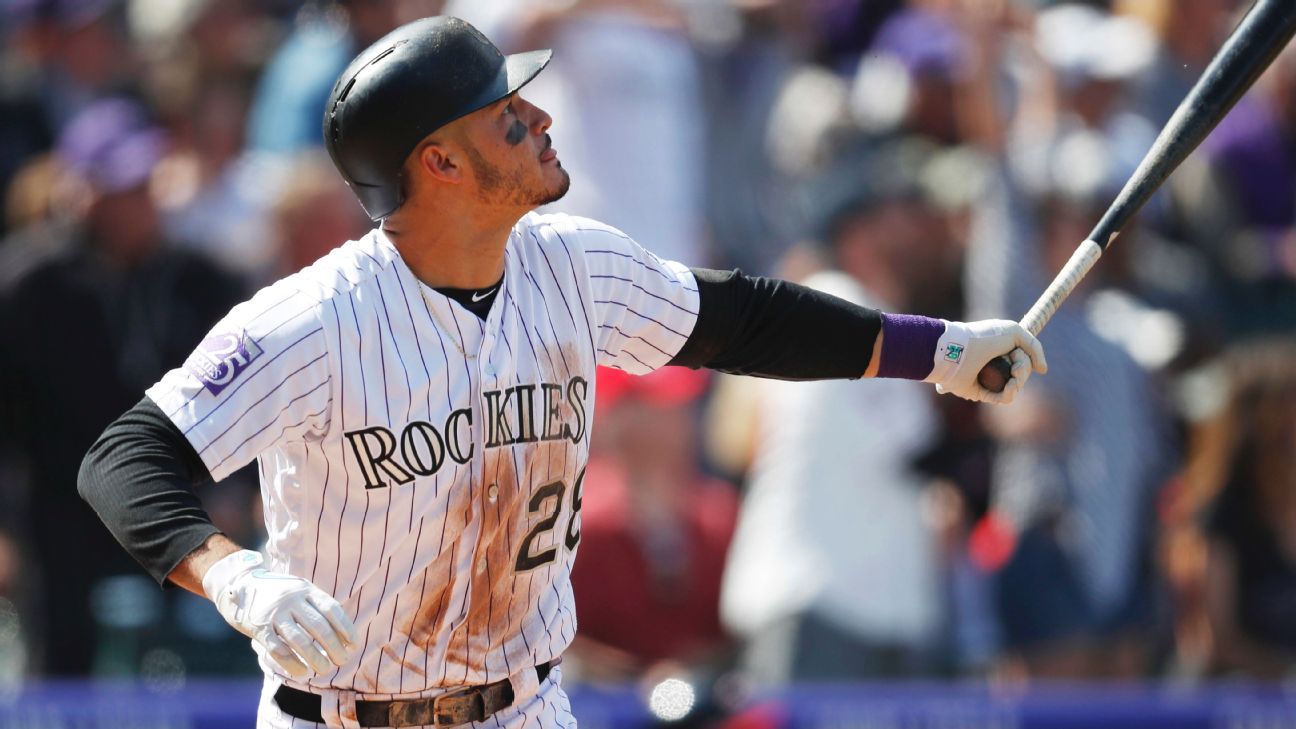Here’s a trivia question you can bring to your cool holiday parties, where the appetite for baseball trivia is no doubt out of control: Which American League first baseman finished highest in MVP voting this year?
It’s a trick question, of course. No player who played primarily first base was named on a single ballot. Of the 18 hitters who got AL MVP votes, only one spent any time at first: Whit Merrifield, a speedy utility player who played all of 44 innings at the cold corner for Kansas City. That’s less time than he spent at second base, center field, right field or designated hitter. But the answer is, somehow, Whit Merrifield. Grab me another drink?
Meanwhile, the top of the ballot was filled with AL third basemen of varied skill sets: Matt Chapman, Alex Bregman and Jose Ramirez all finished in the top seven. The National League had first basemen in contention, but even Freddie Freeman and Paul Goldschmidt finished behind Rockies third baseman Nolan Arenado and Cubs sometimes-third baseman Javier Baez.
These are just anecdotes, names to make the top of this article pop. But the stats suggest something less anecdotal, and perhaps more permanent. An interesting thing might be happening at the corners.
For as long as baseball has been played, defensive position has been offensive destiny. The harder the position, the fewer living human beings who can play it. The smaller that pool of humans, the lower the chance that there will be a bunch of elite hitters among them. And the less important the position, the more a team is willing to live with bad defense in pursuit of more offense.
Here’s a messy chart showing offense (as measured by OPS+) by position by year, going back to 1925:
Messy as it is, you can tell that those nine lines run mostly alongside each other, rather than crisscrossing with each other. Right fielders always outhit center fielders. DHs always outhit catchers. Left fielders always outhit shortstops. Defensive position is offensive destiny.
Very, very occasionally, though, baseball will start to realign itself, and if you unmess that chart, you can see those moments. In the late 1960s, for instance, baseball changed what it thought of the middle infield. Second base and shortstop had long been offensive equals, but teams discovered second base (with fewer plays and a shorter throw than shortstop) was a position where they could stash a bigger, slower, but better-hitting human:
And, for the next 50 years, shortstops didn’t outhit second basemen again. There are blips in the messy chart — every so often center fielders outhit left fielders, or second basemen match third basemen — but the realignments are rare.
So what is happening at the corners, a blip or a realignment? Last year, third basemen hit better (relative to the rest of the league) than they had since 1970. First basemen hit worse than they had since 1951. On Aug. 31, just one point of OPS separated the league’s third and first basemen. Third basemen then had a miserable September, but for the season they still nearly closed the extremely reliable gap between first and third base:
There is, of course, context to this movement. Just a few years ago, baseball writers were in a panic over the disappearing first basemen, who were worse in 2012 than they’d been in years and were nearly absent from top prospect lists. First basemen recovered — 13 got MVP votes in 2015, if we include the DHs who also played first — and the panic looked to have been just one of those fluky aberrations. But here we are again. First basemen are mostly bad. The ones who are good are mostly old. No first baseman this year got a Rookie of the Year vote. And (with some caveats) there are no likely first basemen among at least the top 50 or 60 prospects in the game.
We could list any number of hypotheses — about the role that shifts and strikeouts play in teams’ defensive decisions, about whether easy homers have made slugging first basemen less special, about the impact of super-utility players on each team’s defensive decisions, about the value of athleticism across all levels of the game — but here are two that are accompanied by what I think are interesting data:
1. It’s about bullpens. Yes, bullpens. As starters throw fewer innings and relievers slot into specialized, limited roles, every team carries 12 pitchers and some carry 13. That leaves fewer roster spots for extra hitters and makes versatility almost a requirement for any non-star. The slugging bench bat who offers no defensive versatility is gone; players who can move up and down the defensive spectrum easily fill benches.
Two consequences follow: One is that, when a starting first baseman gets hurt, doesn’t hit or simply needs a day off, there is less likely to be a major league caliber backup ready to take his spot. A marginal first-base prospect might also get fewer chances, and a marginal first-base draft candidate might get passed over, shrinking the pool of future first basemen and future breakout candidates.
The other consequence is that, because there are so few position players available, there’s a very good chance that every utility infielder (or utility outfielder or flexible starter, e.g., Whit Merrifield) is going to end up playing some first base. A record 189 players appeared at first base last year, the fifth year in a row that the league set that record. (Records were also set at second base, third base, center field, right field and catcher. They were nearly set at short, left and DH.) So first basemen move closer and closer to league-average offense because more first-baseman plate appearances are going to whatever average guy happens to be standing around with a glove.
This isn’t only about first basemen. Look at that first chart, and you’ll see almost all positions moving toward the average. Good fielders are forced to play positions at which the offensive standard has traditionally been higher, and good hitters are forced to play positions they were previously considered unqualified to defend. Offense in left field reached all-time lows in 2016 and 2017; right field had its all-time low in 2016 and DH had its all-time low in 2017, as many teams have decided they can’t employ a full-time DH if they’re carrying only 12 hitters. Over the past three years, meanwhile, second basemen and shortstops have been around league-average hitters, the highest they’ve been since the 1940s.
The bottom line is this: Differences among the nine non-pitching positions (as measured by standard deviation) have shrunk this decade to the lowest in history. In the 1970s, batters at “offensive” positions (first base, third base, left field, right field and DH) had an OPS 68 points higher than those at “defensive” positions (catcher, second base, shortstop, center field). Last decade, the difference was 59 points. This decade, the difference is just 39 points.
2. It’s about age. The roster crunch helps explain why first basemen don’t collectively hit as well as they used to — fewer are given chances to break out, and more of the plate appearances are going to non-first basemen — but it doesn’t explain why third basemen are simultaneously having their best seasons in a half-century. Earlier this week, though, we wrote about something that might offer an explanation: Young players are reaching their offensive peaks much earlier.
Nearly every player moves down the defensive spectrum as they age: Shortstops at 23 become second basemen at 29. Second basemen become third basemen. Third basemen become first basemen. And first basemen become DHs as they get thicker, slower, diminished by injury and so on. In any given year, then, the third basemen are going to be collectively younger than the first basemen. Last year, the 30 third basemen who played the most innings were almost two years younger than the 30 first basemen who played the most.
But while defense peaks early and declines almost immediately, the trade-off traditionally has been that the older players become better hitters. As we wrote earlier this week, that trend has reversed. Players are peaking at younger ages, not just in their defense or running skills, but in power hitting, plate discipline and overall offense. Last year’s young players, 25 and under, were better than any young hitters in decades and better than the rest of the league, which is a rarity.
The consequence of that is that third basemen are no longer young defenders waiting for their power to develop at the plate. They’re young defenders who are already developed, who are ready to hit major league pitching.
A third possibility is that this is, in fact, just a blip. Maybe there’s just a bunch of good third basemen right now and a dearth of good first basemen, because sometimes that happens. Just eight years ago, third basemen were as bad as they’ve been in decades, outhit even by second basemen. Just eight years ago, first basemen were dominant, with a collective OPS almost 100 points higher than that of third basemen.
But there’s something about this chart that makes me think it’s probably not a blip:
For most of history — at least since the DH was added to the American League — first basemen, third basemen and DHs tracked each other pretty closely. Sometimes they were a little up, sometimes they were a little down, but they were usually up or down together. This makes sense: The positions overlap a lot, with DHs who often play first base, and first basemen who had just moved over from third base, and first basemen who sometimes play third. If there were a lot of good first basemen, the spillover would benefit third basemen and DHs too. They were a family, and they fluctuated like a family.
Last year, though, they didn’t move like a family. First basemen were as bad as they’d ever been, but the scarcity didn’t affect either of the 1B-adjacent positions. DHs hit better. Third basemen hit better.
It suggests that we could be seeing a realignment around first base. There will always be a handful of walloping sluggers who can only play first base. Some will hit 45 homers and win MVP awards. But the way the game is played today, there might not be room for 30 of that type around the league. We might be seeing first base being pulled into the versatility era. We might see third basemen outhit first basemen in 2019. At least it’s something to watch.
Historical stats via the Play Index at Baseball-Reference.

